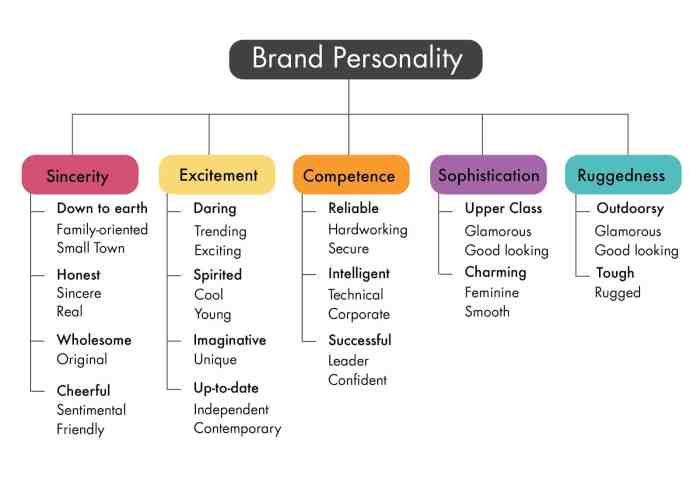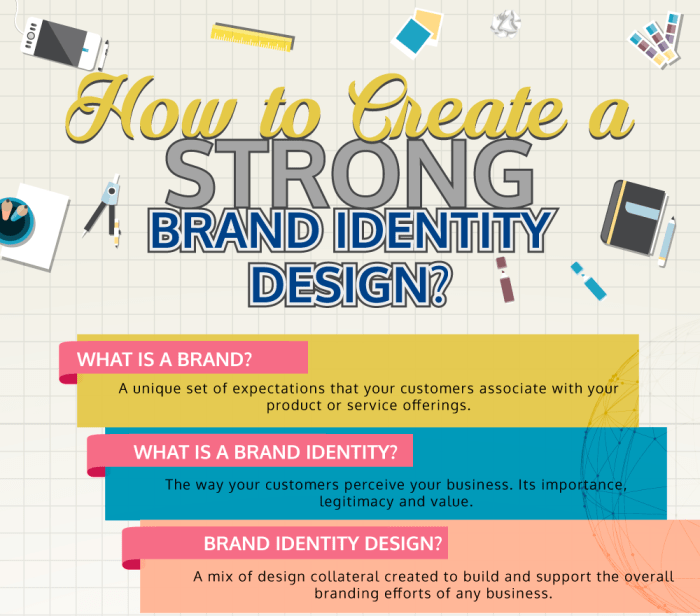Developing Brand Identity: Crafting a Strong Business Image dives into the essence of creating a lasting impression that resonates with consumers and builds loyalty. From logos to market research, this topic covers all the bases in style.
When it comes to standing out in the crowded marketplace, a well-defined brand identity is key. Let’s explore the elements, strategies, and evolution of brand identity to ensure your business makes a lasting impact.
Importance of Brand Identity

Developing a strong brand identity is like the secret sauce for businesses – it sets you apart from the competition, creates a lasting impression on consumers, and builds trust and loyalty over time.
Examples of Successful Companies with Strong Brand Identities, Developing Brand Identity
- Apple: Known for its sleek design, innovative technology, and premium quality products, Apple has built a cult-like following of loyal customers who eagerly await each new product release.
- Nike: With its iconic swoosh logo, “Just Do It” slogan, and association with top athletes, Nike has established itself as a leader in the sports apparel industry, appealing to athletes and fitness enthusiasts worldwide.
- Coca-Cola: The red and white branding, along with its classic logo and memorable advertising campaigns, have made Coca-Cola one of the most recognizable and beloved brands in the world.
How Brand Identity Influences Consumer Perception and Loyalty
Brand identity shapes how consumers view a company, its products, and its values. A strong brand identity can evoke positive emotions, build trust, and create a sense of belonging among customers. This, in turn, leads to increased brand loyalty, repeat purchases, and advocacy among satisfied customers.
Elements of Brand Identity: Developing Brand Identity
Creating a strong brand identity involves several key components that work together to communicate a brand’s values and message effectively.
Logo
The logo is often the most recognizable element of a brand’s identity. It serves as a visual representation of the brand and can evoke certain emotions or associations in consumers. A well-designed logo can help differentiate a brand from its competitors and make it more memorable.
Colors
Color plays a crucial role in brand identity as it can convey different meanings and elicit specific emotions. Consistent use of colors across all brand assets helps create a cohesive and recognizable brand image. For example, blue is often associated with trust and reliability, while red can evoke feelings of excitement or passion.
Typography
Typography refers to the fonts and typefaces used in a brand’s communication materials. The choice of typography can impact how a brand is perceived – whether it’s modern and innovative or traditional and reliable. Consistent use of typography helps reinforce brand recognition and maintain a cohesive visual identity.
Imagery
Images and visual elements also play a significant role in shaping a brand’s identity. The style of photography, illustrations, or graphics used in branding materials can convey the brand’s personality and values. High-quality and relevant imagery can enhance the overall brand experience for consumers.
Messaging
The messaging used in branding materials, such as taglines, slogans, and brand voice, is essential for defining a brand’s identity. Clear and consistent messaging helps establish brand positioning and communicates the brand’s values and mission to consumers. It helps build trust and credibility with the target audience.
Packaging
Packaging design is another crucial element of brand identity, especially for consumer products. The packaging serves as a physical representation of the brand and can influence purchasing decisions. It should align with the brand’s overall aesthetics and effectively communicate the product’s value proposition.
Developing a Brand Identity Strategy
Creating a brand identity strategy is crucial for establishing a strong and recognizable brand in the market. It involves a series of steps that help define what your brand stands for and how it will be perceived by customers.
The Steps Involved in Creating a Brand Identity Strategy
- Define Your Brand’s Purpose and Values: Clearly articulate why your brand exists and what principles it stands for.
- Identify Your Target Audience: Understand who your ideal customers are and what appeals to them.
- Create a Brand Voice and Personality: Develop a tone and style that resonate with your audience.
- Design Your Visual Elements: Choose colors, fonts, and logos that reflect your brand’s personality.
- Establish Brand Guidelines: Set rules for how your brand should be represented across all channels.
The Importance of Market Research and Competitor Analysis
Market research and competitor analysis play a crucial role in developing a unique brand identity. By understanding market trends and studying your competitors, you can identify gaps in the market and position your brand effectively.
Examples of Effective Brand Identity Strategies
- Apple: Known for its sleek design, minimalist aesthetic, and focus on innovation, Apple has built a strong brand identity that resonates with tech-savvy consumers.
- Nike: Nike’s brand identity is centered around empowerment, athleticism, and innovation. Their iconic “Just Do It” slogan encapsulates their brand message perfectly.
- Coca-Cola: Coca-Cola’s brand identity is rooted in happiness, togetherness, and nostalgia. Through consistent branding and messaging, they have become one of the most recognizable brands in the world.
Building Brand Consistency

Maintaining consistency across all brand touchpoints is crucial for establishing a strong and recognizable brand identity. Consistency helps in creating brand recognition and trust among consumers, as they can easily identify and connect with your brand no matter where they encounter it.
Importance of Consistency
Consistency in branding ensures that all marketing materials, online presence, and customer interactions reflect the same messaging, values, and visual elements. This uniformity helps in reinforcing brand identity and differentiating your brand from competitors.
- Consistent branding builds brand recognition and recall among consumers.
- It fosters trust and credibility, as customers know what to expect from your brand.
- It creates a cohesive and professional image, enhancing brand perception.
Tips for Ensuring Consistent Branding
Maintaining brand consistency requires a strategic approach and attention to detail. Here are some tips for businesses to ensure consistency in their marketing materials, online presence, and customer interactions:
- Develop brand guidelines that Artikel key brand elements, such as logo usage, color palette, typography, and tone of voice.
- Train employees on brand standards to ensure consistency in customer interactions and communications.
- Regularly audit and update marketing materials to align with brand guidelines and messaging.
- Monitor online channels to ensure brand consistency in social media posts, website content, and digital advertising.
- Solicit feedback from customers and employees to gauge brand perception and identify areas for improvement.
Evolving Brand Identity
In today’s fast-paced and ever-changing market, it is crucial for brands to continuously evolve their identity to stay relevant and competitive. This process involves adapting to new trends, technologies, and consumer preferences while staying true to the core values and essence of the brand.
Challenges and Benefits of Rebranding
Rebranding or refreshing a brand’s identity can be a daunting task, as it involves risks and challenges such as alienating existing customers, confusing the market, and losing brand equity. However, the benefits of rebranding can outweigh the challenges, as it can help a brand reach new audiences, revitalize its image, and stay ahead of the competition.
- One example of a brand that successfully evolved its identity is Apple. From its humble beginnings as a computer company, Apple has transformed into a global tech giant known for its sleek design, innovation, and user-friendly products. Through strategic rebranding efforts, Apple has managed to stay relevant and maintain a strong brand presence in the ever-changing tech industry.
- Another example is Nike, which has evolved its brand identity from a running shoe company to a global lifestyle brand. By partnering with athletes, celebrities, and designers, Nike has successfully refreshed its image and expanded its reach beyond sports to become a cultural icon.
